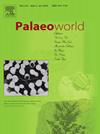Taphonomy of the middle Miocene regular echinoid spines from Cairo-Suez District, Egypt: Palaeoecological and palaeoenvironmental interpretations
IF 1.7
3区 地球科学
Q2 PALEONTOLOGY
引用次数: 0
Abstract
The palaeoecology and palaeoenvironment of a dense cluster of regular echinoid spines that occur in an oyster-rich limestone layer are interpreted based on detailed taphonomic study. The paucispecific macrobenthic assemblage associated with these echinoid spines have been studied in the middle Miocene Geniefa Formation, Gebel Gharra, Cairo-Suez District of Egypt. Both echinoid spines and macrobenthic assemblages are dominated by moderately to well-preserved, moderately packed, highly disarticulated, moderately to poorly sorted, re-oriented, and moderately to highly fragmented specimens, confirming parautochthonous nature of this assemblage. The spines are commonly encrusted and bored. At least four taxonomic groups of encrusters are identified, including juvenile oysters, sheet-like cheilostome bryozoans, serpulids, and balanoid barnacles. The diversity of bioerosional ichnotaxa is moderate and includes Gastrochaenolites, Entobia, Maeandropolydora, Trypanites, and Spirolites. Moreover, some echinoid spines display distinct biting traces of fish, representing the first recorded of fish tooth bite marks on remains of regular echinoid spines from the Miocene deposits of Egypt. The faunal composition and trophic structure of the studied faunal assemblage indicate fully oxygenated and euhaline shallow-marine environment with meso- to eutrophic productivity level. The controlling environmental parameters include substrate consistency, bathymetry, water energy, surface-water productivity, and rate of sedimentation. Furthermore, two scenarios for sclerobionts colonisation and development of fish bite marks have been proposed. In the first syn vivo scenario, predatory fish either focused on the encrusting organisms attached to the spines or attacked the echinoid as a food source, resulting in the separation of spines from their original test during the echinoid’s life. In the second post-mortem scenario, disarticulated spines serve as a hard substrate for the colonisation of sclerobionts. Once again, the spines became subject to attacks by fish that fed on the encrusters, resulting in additional bite marks.
埃及开罗-苏伊士地区中新世规则棘皮动物的岩石学研究:古生态学和古环境解释
根据详细的岩石学研究,对出现在富含牡蛎的石灰岩层中的密集的规则棘皮动物群的古生态学和古环境进行了解释。在埃及开罗-苏伊士地区 Gebel Gharra 的中新世中期 Geniefa 地层中,对与这些棘皮动物相关的大型底栖生物组合进行了研究。回声棘和大型底栖生物集合体的主要标本都是保存中等至良好、中等包装、高度解体、中等至差度分选、重新定向以及中等至高度破碎的标本,这证实了该集合体的副同源性质。棘刺上通常有包壳和钻孔。至少确定了四类包壳动物,包括幼年牡蛎、片状螯足类双壳类动物、蛇尾类动物和槌状藤壶。生物气孔迭加类的多样性适中,包括 Gastrochaenolites、Entobia、Maeandropolydora、Trypanites 和 Spirolites。此外,一些棘皮动物的棘刺上有明显的鱼类咬痕,这是埃及中新世沉积物中首次记录到有规律的棘皮动物棘刺残骸上有鱼齿咬痕。所研究动物群的动物组成和营养结构表明,浅海环境中氧气充足,水质富营养化,生产力处于中度到富营养化水平。控制环境参数包括底质稠度、水深、水能、表层水生产力和沉积速率。此外,还提出了硬骨鱼类定殖和鱼类咬痕形成的两种情况。第一种情况是,捕食性鱼类要么将重点放在附着在棘刺上的硬壳生物上,要么将棘刺作为食物来源进行攻击,从而导致棘刺在棘刺的生命周期内从其原始测试中分离出来。在第二种死后情况中,脱节的棘刺成为硬壳虫定居的硬基质。这些棘刺再次受到以硬壳虫为食的鱼类的攻击,造成更多的咬痕。
本文章由计算机程序翻译,如有差异,请以英文原文为准。
求助全文
约1分钟内获得全文
求助全文
来源期刊

Palaeoworld
PALEONTOLOGY-
CiteScore
4.00
自引率
5.90%
发文量
95
期刊介绍:
Palaeoworld is a peer-reviewed quarterly journal dedicated to the study of past life and its environment. We encourage submission of original manuscripts on all aspects of palaeontology and stratigraphy, comparisons of regional and global data in time and space, and results generated by interdisciplinary investigations in related fields. Some issues will be devoted entirely to a special theme whereas others will be composed of contributed articles. Palaeoworld is dedicated to serving a broad spectrum of geoscientists and palaeobiologists as well as serving as a resource for students in fields as diverse as palaeobiology, evolutionary biology, taxonomy and phylogeny, geobiology, historical geology, and palaeoenvironment.
Palaeoworld publishes original articles in the following areas:
•Phylogeny and taxonomic studies of all fossil groups
•Biostratigraphy, chemostratigraphy, chronostratigraphy
•Palaeoecology, palaeoenvironment and global changes throughout Earth history
•Tempo and mode of biological evolution
•Biological events in Earth history (e.g., extinctions, radiations)
•Ecosystem evolution
•Geobiology and molecular palaeobiology
•Palaeontological and stratigraphic methods
•Interdisciplinary studies focusing on fossils and strata
 求助内容:
求助内容: 应助结果提醒方式:
应助结果提醒方式:


